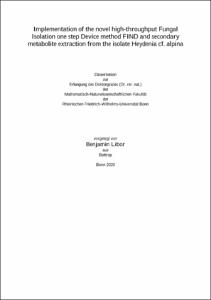Libor, Benjamin: Implementation of the novel high-throughput Fungal Isolation one step Device method FIND and secondary metabolite extraction from the isolate Heydenia cf. alpina. - Bonn, 2021. - Dissertation, Rheinische Friedrich-Wilhelms-Universität Bonn.
Online-Ausgabe in bonndoc: https://nbn-resolving.org/urn:nbn:de:hbz:5-62850
Online-Ausgabe in bonndoc: https://nbn-resolving.org/urn:nbn:de:hbz:5-62850
@phdthesis{handle:20.500.11811/9217,
urn: https://nbn-resolving.org/urn:nbn:de:hbz:5-62850,
author = {{Benjamin Libor}},
title = {Implementation of the novel high-throughput Fungal Isolation one step Device method FIND and secondary metabolite extraction from the isolate Heydenia cf. alpina},
school = {Rheinische Friedrich-Wilhelms-Universität Bonn},
year = 2021,
month = jul,
note = {Fungi are an important source of bioactive metabolites. The cultivation of source organisms is a crucial step in natural product isolation. With standard isolation methods for fungi it is difficult to isolate rare und underexamined fungi from environmental samples. The Fungal one-step IsolatioN Device (FIND) technology allows the isolation of rare fungi from terrestrial and marine samples. The FIND comprises a multi-chambered micro agar plate, where initially only one fungal part (e.g., hyphal cell, mycelial fragment or spore) is located in each chamber. After inoculation the device is placed back into the original natural environment of sample collection, to ensure favourable growth conditions. A comprehensive analysis of state-of-the-art isolation techniques for filamentous fungi emphasises the advantages of the FIND method compared to the standard isolation methods.
With the FIND, it was possible to isolate 12 rare and underexamined axenic fungal cultures directly from their sample sources, i.e. terrestrial soil, sea sediment and seawater, without any purification or passaging steps. The taxonomy of nine of these strains could be determined to species level by DNA sequencing. One of the isolated fungi, i.e. Heydenia cf. alpina (strain 824) was never before investigated chemically and cultures of our strain yielded three novel compounds, namely heydenoic acid A (1), heydenoic acid B (2) and (3E,6E)-4,6,8-trimethyldodeca-3,6-diendioic acid (8). The first two compounds belong to the sesquiterpene family of bergamotenes.
Using the latest approaches, i.e. HRMS based dereplication (GNPS) and deep learning NMR guided structure elucidation (SMART), fascinating insights into the metabolome of Heydenia cf. alpina were displayed, after challenging cultures of this strain with varying (partially extreme) conditions (OSMAC).},
url = {https://hdl.handle.net/20.500.11811/9217}
}
urn: https://nbn-resolving.org/urn:nbn:de:hbz:5-62850,
author = {{Benjamin Libor}},
title = {Implementation of the novel high-throughput Fungal Isolation one step Device method FIND and secondary metabolite extraction from the isolate Heydenia cf. alpina},
school = {Rheinische Friedrich-Wilhelms-Universität Bonn},
year = 2021,
month = jul,
note = {Fungi are an important source of bioactive metabolites. The cultivation of source organisms is a crucial step in natural product isolation. With standard isolation methods for fungi it is difficult to isolate rare und underexamined fungi from environmental samples. The Fungal one-step IsolatioN Device (FIND) technology allows the isolation of rare fungi from terrestrial and marine samples. The FIND comprises a multi-chambered micro agar plate, where initially only one fungal part (e.g., hyphal cell, mycelial fragment or spore) is located in each chamber. After inoculation the device is placed back into the original natural environment of sample collection, to ensure favourable growth conditions. A comprehensive analysis of state-of-the-art isolation techniques for filamentous fungi emphasises the advantages of the FIND method compared to the standard isolation methods.
With the FIND, it was possible to isolate 12 rare and underexamined axenic fungal cultures directly from their sample sources, i.e. terrestrial soil, sea sediment and seawater, without any purification or passaging steps. The taxonomy of nine of these strains could be determined to species level by DNA sequencing. One of the isolated fungi, i.e. Heydenia cf. alpina (strain 824) was never before investigated chemically and cultures of our strain yielded three novel compounds, namely heydenoic acid A (1), heydenoic acid B (2) and (3E,6E)-4,6,8-trimethyldodeca-3,6-diendioic acid (8). The first two compounds belong to the sesquiterpene family of bergamotenes.
Using the latest approaches, i.e. HRMS based dereplication (GNPS) and deep learning NMR guided structure elucidation (SMART), fascinating insights into the metabolome of Heydenia cf. alpina were displayed, after challenging cultures of this strain with varying (partially extreme) conditions (OSMAC).},
url = {https://hdl.handle.net/20.500.11811/9217}
}






